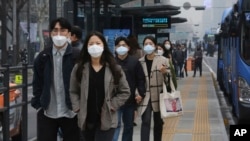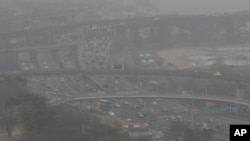South Korea is seeking cooperation from China to produce artificial rain to help fight increasing pollution.
President Moon Jae-in proposed the plan this week during a meeting with government officials, his spokesman said.
South Korea has reached a new high in a kind of air pollution measured in fine dust. On one recent day, officials said the fine dust concentration levels in Seoul rose above 130 micrograms per cubic meter. Levels above 75 micrograms per cubic meter are considered “very bad.” The rising levels caused some people to wear face coverings to protect them from the thick, gray air.
The proposal with China would involve a project to create artificial rain. This process involves cloud seeding – when various substances are put into clouds in an attempt to cause rain.
In a meeting with a top Chinese diplomat last year, Moon said China was partly responsible for South Korea’s pollution problem. He called for China’s cooperation in efforts to improve air quality.
When asked about Moon’s latest proposal, Chinese foreign ministry spokesman Lu Kang welcomed cooperation with South Korea. But he questioned South Korean claims that China is a major source of its pollution.
“I wonder if the South Korean side has any basis that its smog is from China,” Lu told reporters. He noted that fine dust readings have been higher in Seoul than in Beijing recently. “All countries realize that the cause is very complicated,” he added.
One South Korean opposition party called on Moon to declare the current air pollution problem a national disaster. Lawmakers from the ruling and opposition parties held an emergency meeting and agreed to quickly consider legislation to deal with the problem.
In a meeting with government officials, Moon noted that China was “much more advanced” than South Korea in rain-making technologies, his spokesman said. The president expressed hope that creating rain over waters between the countries would help reduce air pollution.
“China has claimed that South Korea’s dust flies toward Shanghai. So creating artificial rain over the Yellow Sea would help the Chinese side too,” the spokesman said Kim told the meeting.
South Korean officials announced last month that an experiment to create artificial rain did not provide the desired results. In January, the country’s weather agency sent aircraft to release chemicals into clouds over the Yellow Sea, South Korea’s Yonhap news agency reported. The Yellow Sea sits between the Korean Peninsula and China.
South Korea’s Ministry of Environment said in a news release that no major precipitation was observed after the cloud seeding operation. Some cloud formation was confirmed and rainfall was observed over some islands, the release said. But no rain was observed in inland areas, it added.
Moon has also requested that government officials take additional steps to help fight pollution, his spokesman said. Those include acting to quickly close long-operating coal-burning power plants. He also proposed putting more air purifiers in schools and to explore additional anti-pollution efforts with China.
I’m Bryan Lynn.
Bryan Lynn wrote this story, based on reports from the Associated Press, Reuters and Yonhap news agency. Caty Weaver was the editor.
We want to hear from you. Write to us in the Comments section, and visit our Facebook page.
_________________________________________________________________
Words in This Story
artificial – adj. not natural, but made by people
concentration – n. a large amount of something in one place
smog – n. air pollution
complicated – adj. hard or difficult
advance – adj. far on in time or course
precipitation – n. rain or snow that falls to the ground










